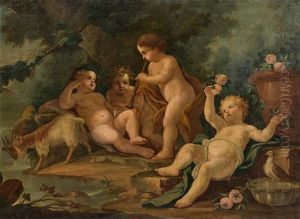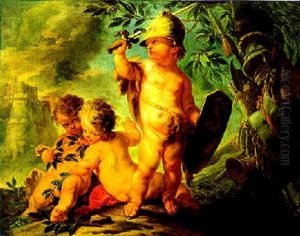Peter Strudel Paintings
Peter Strudel was an Austrian painter, sculptor, and architect, born in 1660 in Heidelberg, Germany, and later became a prominent figure in the Baroque art movement in Austria. He is particularly known for founding the Strudelhof, an important academy of fine arts in Vienna, which significantly contributed to the development of Austrian art in the late 17th and early 18th centuries. Strudel's work and influence were instrumental in shaping the artistic landscape of his time, bringing about a blend of Italian Baroque elements with local artistic traditions.
Strudel's journey into the arts began in his early years, learning the basics of painting and sculpture likely from family members or local craftsmen. His talent soon became apparent, and he traveled to Italy, a common practice among artists of the period seeking to refine their skills and absorb the Renaissance and Baroque artistic heritage. In Italy, Strudel was exposed to the works of masters such as Caravaggio, Bernini, and Borromini, which had a lasting impact on his artistic development. Upon his return to the German-speaking regions, he brought with him the grandeur and dynamism of Italian Baroque, which he adeptly fused with the Northern European artistic sensibility.
In 1686, Strudel was appointed court painter by Emperor Leopold I, a position that not only elevated his status but also provided him with numerous commissions, including portraits, religious compositions, and decorative schemes for palaces and churches. His success and recognition at court allowed him the resources and influence to establish the Strudelhof in 1692, an academy that aimed to train artists in both theoretical knowledge and practical skills. This institution was a significant departure from the guild system, offering a more formalized and comprehensive approach to art education.
Peter Strudel's legacy is not only in his artworks but also in his contributions to the Austrian art scene through his teaching and the establishment of the Strudelhof. His approach to art as a blend of emotional expression and technical precision left a lasting mark on his students and the direction of Austrian Baroque art. Strudel died in 1714 in Vienna, but his impact on the art world continued to be felt, paving the way for the next generation of artists in Austria and beyond.













